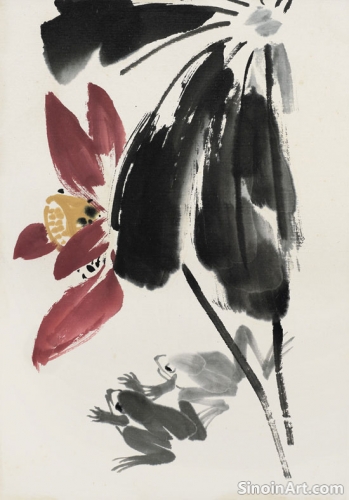The Concept of "Qing" in Xieyi Painting
|
"Qing" (情), often translated as "feeling," "emotion," or "inner sentiment," is a fundamental concept in Xieyi painting, referring to the artist's ability to imbue their works with a sense of personal feeling, emotion, and genuine expression. It’s not just about depicting a scene, it’s about conveying the feelings that it evokes within the artist. The feeling that drives the artistic process is what makes the art form so powerful and moving.  The pursuit of qing requires the artist to connect with their own inner emotions, to observe the world with sensitivity, and to express their feelings through the language of ink and brush. The goal is to reach a point of deep understanding of the human condition and to communicate that through the medium of painting. The artist must be in alignment with their creative intent.  The feeling within an artwork should be genuine and authentic, reflecting the artist's true state of mind, rather than simply trying to create something beautiful or technically proficient. It must come from the heart and soul of the artist, and not simply from their conscious intellect. The art should feel real and emotionally powerful to the viewer.  The ability to convey emotion through brushstrokes, ink washes, and the overall composition of the work is a mark of a skilled Xieyi painter, capable of touching the hearts and minds of viewers. The way that the ink is applied, and the strategic choices of line work create an emotional impact on the viewer. It has the power to resonate with and inspire a powerful emotional response. Ultimately, qing reflects the belief that art should be a means of personal expression, a way for artists to share their inner world, connect with others, and explore the universal emotions that unite us all. It speaks to the underlying human experience, and is able to touch the heart of the observer. It is a powerful means of connection and shared understanding. |
Tag : Qing, feeling in art, emotional painting, expressive art, Xieyi sentiment
Related information
- The Legacy and Future of Xieyi Painting
- Xieyi and the Concept of "Shu Hua Tong Yuan"
- The Role of the Brush in Xieyi Painting
- Xieyi Painting and the Depiction of Landscapes
- Xieyi Painting and the Depiction of Animals
Xieyi painting, with its rich history and unique aesthetic, continues to hold significance and inspire artists, influencing contemporary art globally, ensuring the continuation of its traditions, and its continued evolution and relevance as it continues to express cultural values and universal truths, making it an enduring art form.
"Shu Hua Tong Yuan" (calligraphy and painting share the same source) is a fundamental concept in Chinese art and Xieyi painting, highlighting the shared tools, techniques, aesthetic principles, and expressive potential between calligraphy and painting, with calligraphic brushwork central to the Xieyi technique.
The Chinese brush is essential to Xieyi painting, serving as an extension of the artist's hand and mind. Mastering brush types, grip, pressure, and stroke is crucial for creating the diverse range of expressive marks and textures characteristic of the art form.
Xieyi landscapes (shānshuǐ) emphasize grandeur, depth, and qi, using negative space and suggestive brushstrokes to capture the essence, atmosphere, and inner vitality of the natural world, and expressing the artist’s connection to nature and understanding of the Tao.
Animals are a common subject in Xieyi painting, used to express emotions, convey philosophical ideas, and capture the essence of the animal with simplified forms and spontaneous brushstrokes, relying on cultural symbolism and careful observation of the natural world, often as metaphors for the human condition.